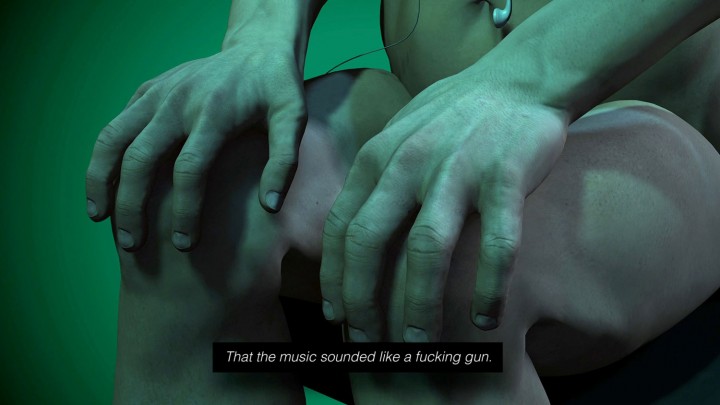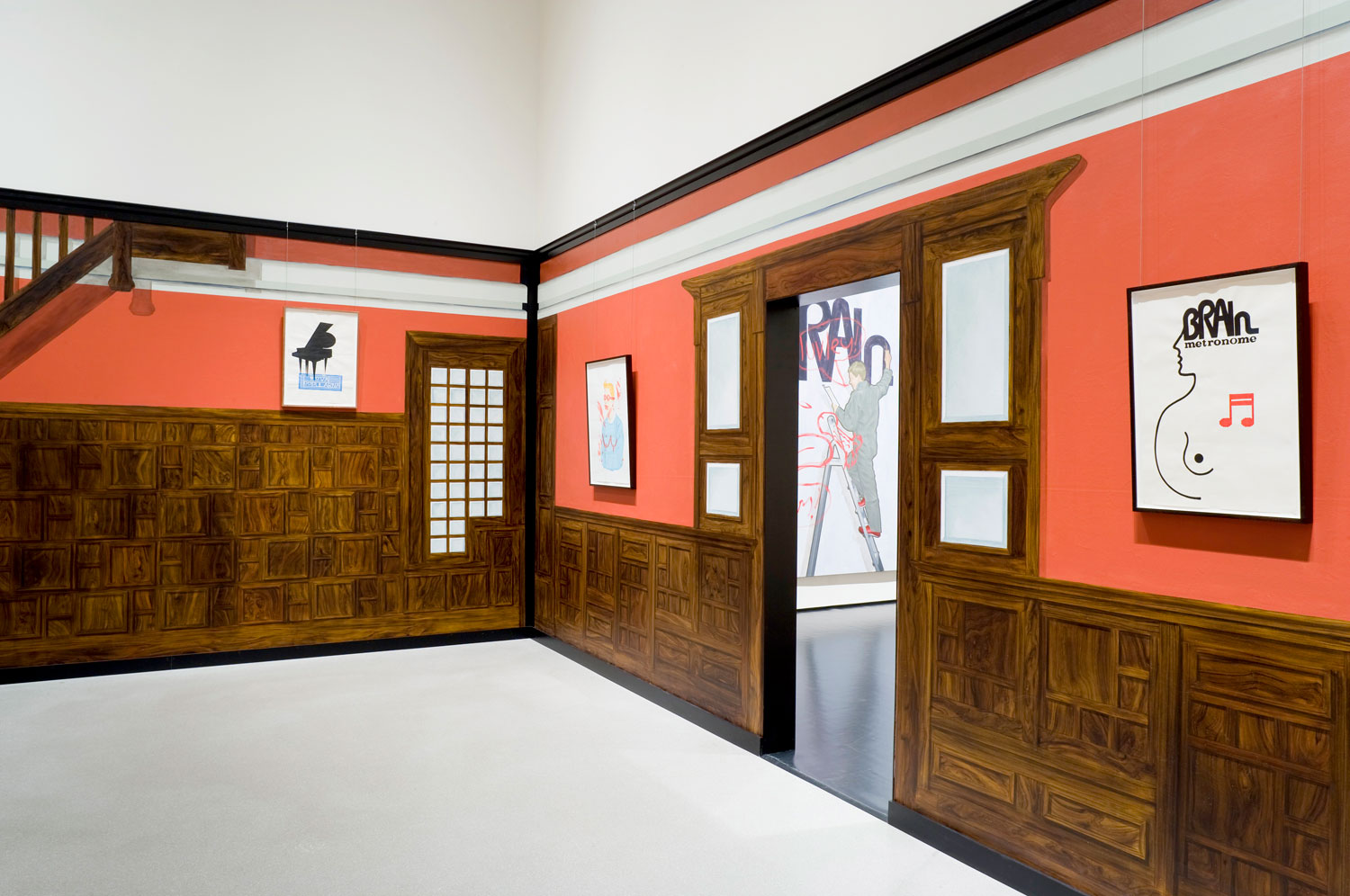
Klaus Biesenbach: What is your working process? Do you start with text and then the image comes? Or do you have an image that you then pair with text?
Ed Atkins: It tends to be something a little more confused than that. As in, things are gathered, notes are taken, images and methods are stockpiled — centering around whatever nodal tenet — then there’s some great blurt of production which is where everything is brought together. I have a certain necessary faith in the coincidence of forms and thoughts where in their meeting and melding something altogether unexpected might be generated. Which is perhaps equivalent to saying I have faith in editing and the point at which editing becomes generative. It’s also a pragmatic reality, in the sense that the work so far has been made pretty much entirely on a laptop, where those apparently constituent disciplines — writing, image-making, sound composition and all those openings onto the rest of the world — are composited.
KB: Now I really feel like I’m in a piece of yours. Can you, please, try to say this again in a slightly different way?
EA: My working process is pretty disordered, stuttering. A lot of time is spent gathering resources — notes, ideas, images, recordings, samples, etc. — in advance of the edit. Pretty much everything is sourced through the laptop, the laptop acting as a siphon for everything in the world. There’s a point at which “production” conspicuously begins, which is when everything is handled pretty much simultaneously — or as simultaneously as possible. The production consists pretty much entirely of editing and generating: making the videos is an editing process, scraping back the dreck of whatever I’d accumulated — whereas the writing is often a counter movement of excessive generation, of writing more than was there in the first place. Again, the laptop is the place where all this happens, for practical as well as conceptual reasons. It’s where everything is materially homogenized, and the kind of interaction I can have with the stuff it plays host to seems pretty much omnipotent.

KB: Is your laptop an extension of your body?
EA: I might speak in the same equally erroneous way about my body, my brain. This production process — the flurry of editing and generating — is more often than not anxious. This means that it is laced with the anxiety of production to such an extent that, like most people, I suspect, I might begin to fear the ever-increasing pathological nature of my working method. Though, I suspect, it’s precisely the performance of that anxiety and desperation that produces those parts of the work that allude precisely to this sort of pragmatic understanding, which is a worry and also a means by which I can return to a relatively lucid, presentable self once the work’s finished.
KB: How do you produce physical images? Is it all made in the computer or are you actually filming sequences from reality?
EA: These days — for the past few video works — it’s been almost entirely made in-computer. By “in-computer” I would also include appropriation; the vast majority of cultural material I encounter solely through the computer, and on my own. I’ve recently had recourse to a wonderful computer animator, though we really only communicate through elaborate emails and images. There are some things that I shoot with a camera, but these are more often than not prepped for computerization — everything is cluttered and back-dropped with Chromakey green swatches and apparatus that, once on the computer, means I can edit the image according to processes in the computer. And although this might seem like a conceptually encumbered gesture, I would again say that it was something born of the practicalities of a practice, too: the concept and the practicality are inextricably linked.
KB: Your work would have not been feasible to produce ten years ago. There was no hardware or software for it — it’s really only now that images like those you produce are available.
EA: Being able to make moving-image work on a laptop is a phenomenal thing. I’ve been thinking recently that, really, it’s the convenience and speed of computing as it has emerged in the consumer market over the past few years that has really made the difference for me. The kind of work that it became possible to make allowed for an immediacy of thought translated into image; the gap between what I fantasize and the realization of that fantasy — albeit within the fantasy of the computer — opened a huge new terrain of possibility. With that in mind I could tap a seam of thought and desire that would have previously been dissipated before it had a chance to appear.


KB: Is your brain, your thinking and your artistic practice changing according to this?
EA: The ability to control on the computer; the ability to undo; the sheer possibility of recourse to anything at the moment of production; the peculiarities of authorship and performance according to the laptop and its tacit promises — these are social rehearsals which can be edited and retrieved and re-performed according to a fantasy of dematerialization. Until they are exported and presented, they are embroiled in some infinitely correctible, narcissistic body within the computer. Right now, from here, I can merely speak around the work: I can only see that of which I speak properly if I close my eyes, inside the computer, up against it. The rest, like this, is the need to say something — to say too much, probably — in the yawning lack of the thing itself.
KB: It seems to me that you’re using stock footage. I don’t know if you take imagery from advertising, stock images or stock videos. There is a commercial aesthetic, which is then broken by something utterly personal.
EA: The images I use are pretty much entirely conditioned by computers in one way or another. Which isn’t necessarily to say that they’re made in the computer, but that I arrive at them through it. So yes, there’s a lot of stock imagery in there, but there’s also a fair amount of stuff that I’ve made thatlooks like stock — stuff I’ve shot with all the ambivalence and indeterminacy of stock. There’s a quality to these kinds of images I really appreciate, particularly as someone who makes things: they’re incomplete images — images that seem to speculate about their immanent value or use without determining either. My use of this stuff is part of their aspiration as stock images. Similarly, when I’m making something to look like stock, there is always that sense of excitement when filming or whatever, thinking about all the amazing manipulative things I could do with this pretty blank, almost empty image. It meant that everything I would do to it was so much more conspicuous. Those things that I can do to images in the computer are based on my reading of them and my desires projected toward them. I suppose that most of the interruptions and filters and changes I make to the images are the point at which I assert myself, my power. This means that a lot of stuff either is deeply personal or, generally speaking, “un-re-presentable.” Understanding those sorts of gestures as resistance, perhaps. Wanting to be close to my audience, to share and risk something for the promise of empathy or graciousness.

KB: How would do you describe the product? Would you describe yourself as a sculptor, like Matthew Barney? Would you call yourself a conceptual artist?
EA: I would not describe it as a product, I suppose. Though I produce it, I’d rather imagine it as something more spontaneous — though more in a sense like “spontaneous combustion” than some instinctive and positive resource that has been tapped. And there are so many things I’d like to call myself, but it’s hard. It all sits uncomfortably, as I’m sure is the case with most of us; categorical designation is suspicious. If, however, I could retrieve it from any professional affiliation, I’d like to say I was a writer. I think that language is still a massive problem for me — and also the only way that is so intimately, duplicitously reflexive — as in: “here is language.” It is my only descriptive faculty. And yet those subjects — those experiences — that precisely evade language are the only things I want to describe! It’s a great heap of paradoxes that, despite and because of its totally obvious unfeasibility, it is where I feel most stable, albeit precariously. So maybe something like an “un-writer.” Certainly I’m an apologist for experience — for “nowness.”
KB: Is there any artist, writer or filmmaker that inspired you when you were a student?
EA: Definitely. I was totally enthralled to Donald Barthelme during my BA. Which is probably still true. His sleight and stylish formal radicalism is pretty astonishing to anyone at any age, but particularly for me in my early twenties it pretty much rewired my brain. From him, too, there are infinite fascinating and divergent paths. There are a few filmmakers who have been incredibly important to me — as I pretty much imagine they have been for so many: Robert Bresson, Jan Švankmajer, John Cassavetes. A bit of a weird mix, maybe, but my love of their stuff flows embarrassingly legibly into my own stuff. On my MA I listened to Graham Lambkin over and over and over: similarly, his stuff was overwhelmingly important — visual artists less so.
KB: In 10 years from now what would you like to do?
EA: Something completely different. I remember wanting to be a butler when I was a kid.





